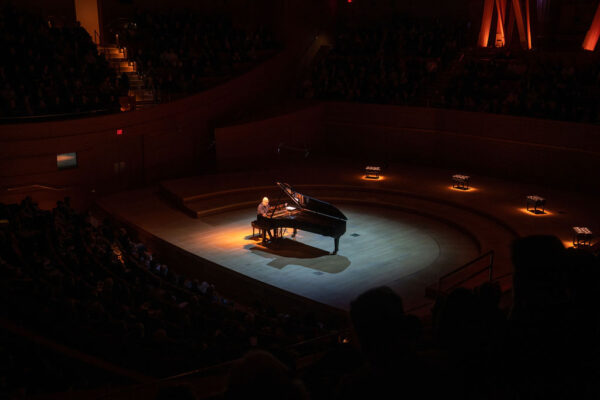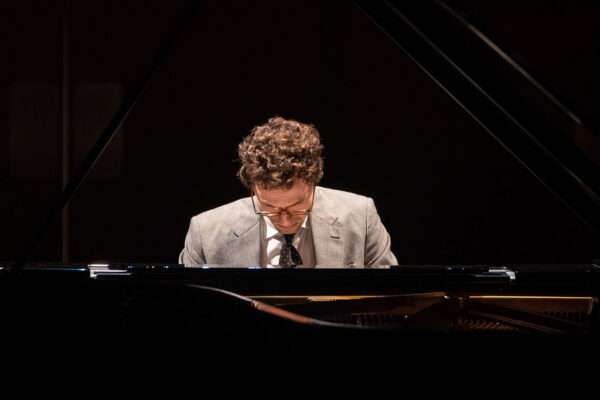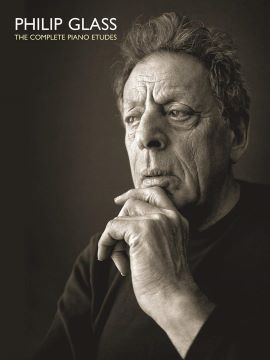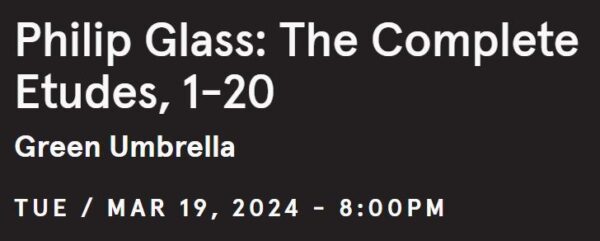FOR SOME, THIS GLASS IS HALF-EMPTY.
MINE OVERFLOWETH.
Although Philip Glass‘s works can be described as minimalist, he prefers to describe himself as a composer of “music with repetitive structures.” He also noted, “If I’m to be remembered for anything, it will probably be for the piano music, because people can play it.” He conceived The Etudes as a set of 20 works for solo piano written to improve his own performance technique. His most personal body of work, the pieces are a self-portrait of a life’s practice, representing some of the most intimate and inventive music of Glass’s oeuvre. And the sold-out crowd last night at Disney Hall heard five world-class alternating pianists take on four pieces each with such craftiness and finesse that one would find it hard to refute that they heard them done better. Some used digital pads, some sheet music, while others, remarkably, had them memorized. All five pianists recently played Carnegie Hall in the same program but with ten players, and a few have already recorded the miniature musical masterpieces.
Maki Namekawa
But first, the music. With more than 9 string quartets, 14 symphonies, 13 concertos, and numerous soundtracks to films (Koyaanisqatsi, The Hours), Glass’s work may be rooted in minimalism, but he’s so much more than that. Typical Glassian features are when the smallest change has the greatest significance, with mesmerizing, mantra-like arrangements of notes that delicately move away from one another. Of his 30 operas, the most famous include Akhnaten , Satyagraha, and Einstein on the Beach — the latter being one of the most thrilling nights I’ve ever experienced. Perhaps there was something mathematical or perfectly in harmony with nature (or in nature with the harmonies of molecular structure itself), but my experiences with his opera work were positively transcendent (at 15, Glass studied mathematics and philosophy at the University of Chicago). I was hooked by his use of repetitive sounds over long periods, which have a hypnotic, meditative feel.
Jenny Linn
So, what are etudes? Etudes are different from variations. Etudes are short pieces but they have different themes and are intended as an exercise for the hands or to demonstrate the proficiency of the player. When you have a set of variations they are all connected by the same theme. When you have a set of etudes there is nothing, usually, that connects them. Here, each work has a unique character traversing through varying keys and scales. Some are all about pure technique while others also demonstrate expressive considerations. Along with fluid arpeggios, you may be surprised to hear train-chugging rhythms and ragtime syncopation.
Jenny Linn
I got my first taste of his Etudes live last December at The Joyce in Manhattan at Dancing with Glass: The Piano Etudes, during which 11 of his 20 pieces were interpreted by pianist Maki Namekawa, who played last night. In her hands, Glass’s music, which may seem simple and repetitive, suddenly bursts alive with hidden melodies and nuggets of gold. Fascinatingly enough in NY, the pieces did not inspire the likes of both Justin Peck and Lucinda Childs, who each offered their own dance interpretations of the Etudes. While this program failed, it offered insight as to why the minimalistic staging of his operas works best to accompany his works.

Anton Batagov
The only movement last night came courtesy of a tiny backstage crew of two, who came out to move piano benches, which were lined up and spotlit in a semi-circle behind the grand piano, with its lid wide open. The lighting design by John Torres confirmed the aesthetics of Disney Hall by backlighting the famous “french-fries” organ in a nightly blue.
Lara Downes
While I loved having my soul melt away for 2 and 1/2 hours, many of the Etudes are are rapturously meditative and reflective, a lovely and perfect accompaniment for a rainy night, or perhaps one on edibles and caffeine, but quite a few patrons found it to be an endurance test, noisily dropping phones and — as if to awaken themselves — applauding before the artists’ fingers had even left the keys. (When the piano bench movers appeared for the first time, they were greeted with thunderous applause reserved for the pianists.) A good chunk of patrons left at intermission, and even more during the final 10 pieces. When some viewers left after #16, a friend behind me said, “Oh, my God. They’re going to miss 17.” Which was amusing because I know they all sounded the same to him.
Maki Namekawa
But not to me. Composed between 1991 and 2012, the 20 sweepingly diverse and intricately melodic Etudes are among Philip Glass’s most beautiful and inventive works. Along with Namekawa, our players were Timo Andres (who, as a composer, offers a world premiere piano concerto opens Friday with the LA Phil), Anton Batagov, Lara Downes and Jenny Lin. The women changed outfits at intermission, with Namekawa in a flowing white outfit that was a love child of a kimono and a hoop skirt. There was a world of difference between Downes’ technical proficiency, Linn’s precision, Namekawa’s rich colours, and Batagov’s dreamy introspection. Highlights included Downes in the playful, lucid Etude 10 and Namekawa in the elegiac Etude 20, with its fascinating harmonics. Best of all was Andres in the supersensitive stillness of Etude 5 and the amazing octave work and articulate intelligence in Etude 6. He is a star.


Timo Andres
These worldwide concerts of the Etudes even have a tie-in: I took a look at Etudes (Artisan), a boxed set that includes the Complete Etudes 1-20 and a hardcover book Studies in Time: Essays on the Music of Philip Glass. It’s quite handsome, but I suggest you buy online for about 90 bucks instead of the $150 price tag at the hall’s gift shop.
Curtain Call
photos by Halline Overby for the Los Angeles Philharmonic



{ 1 comment… read it below or add one }
Thank you for this appreciative review. I was at the same concert and loved it at least as much. I would only add that my favorite was Andres’ rendition of #12. He literally embodied the syncopation in the work – the “jazziest” of all the Etudes – far more than other performers’ versions that I have heard before or since.